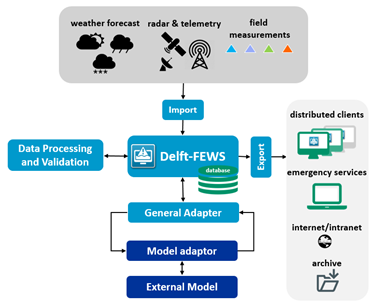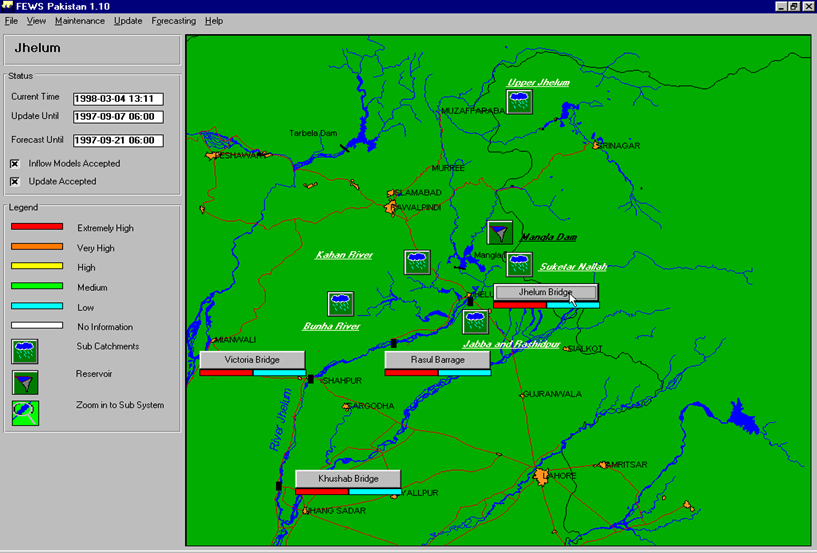- Delft-FEWS Hardware and software requirements
- Delft-FEWS Release Notes
- Delft-FEWS Copyrights and Credits
Since its introduction in 2002/2003, the current generation of the Delft-FEWS operational forecasting platform has found application in over fourty operational forecasting centers worldwide. The platform is used to link data and models in real time and to produce forecasts on a daily basis. In some cases it forms a building block of a country-wide national or even international forecasting system using distributed client-server technology. In other cases it is applied at a much smaller scale on a simple desktop workstation, providing forecasts for a single basin. The flexibility of the software in open integration of models and data has additionally appealed to the research community and year-on-year hundreds of features are added.
Delft-FEWS provides an open shell system for managing forecasting processes and/or handling time series data. Delft-FEWS incorporates a wide range of general data handling utilities, while providing an open interface to any external (forecasting) model. The modular and highly configurable nature of Delft-FEWS allows it to be used effectively for data storage and retrieval tasks, simple forecasting systems and in highly complex systems utilizing a full range of modeling techniques. Delft-FEWS can either be deployed in a stand-alone, manually driven environment, or in a fully automated distributed client-server environment.
The modular architecture of Delft-FEWS is of major importance as it allows making maximum and cost-efficient use of past investments in a diversity of modelling solutions such as HEC, MIKE, HBV, SOBEK etc. Modelling traditions and systems can thus be accommodated and allowed to continue.
In general the main advantages to work with Delft-FEWS are:
- Ease of implementation and change. The configuration of the system takes place in csv-files, xml-files and shape-files. This means that the complete configuration is accessible for the advanced-user. This also ensures that advanced-users and other parties are able to do system adjustments without needing the Consultant after delivery of the system. Where other forecasting systems might depend on external software (like ArcGIS) or have fixed configuration depending on the original developer, Delft-FEWS has a much more flexible and open approach.
- Easy distribution to users. The system works under Java, so it is independent of the operating system. There is no need to install additional client software.
- Expandability. When new models or new telemetry data become available, they can easily be included. This allows the system to grow at the user’s pace.
- Tailor made. Using Delft-FEWS, the flood forecasting system can be customized according to the wishes of the Client.
- Proven technology. The Delft-FEWS system is being used worldwide to do flood forecasting and time series management. It can run on industry Within all these implementations different third party information sources and models were used. Input and output adapters that provide for proper communication between Delft-FEWS and the third party models have been developed for more than 100 information sources and more than 50 applications and simulation modules at least.
- Multilingual. The Delft FEWS system is available in several languages. All text of the user interface is isolated in two text files. A language can be added simply by adding translated versions of these files.
- Economical. The system is available against zero licence costs. This means that the Client signs an agreement with the software supplier (Deltares) with no cost.
Some more history
The current version of Delft-FEWS is built on the past experience from forecasting systems that Deltares developed for Sudan, Pakistan and Czech Republic during the 90s, as well as for the Dutch government for the Rhine and Meuse. Already then, the need for a separate GUI, data and model was recognized and the concept of model adapters was applied.
Around 2000, the first Delft-FEWS software was developed, based on Java, initiated by various projects like the European Flood Forecasting System, FEWS Switzerland, Rhine and Tanshui (Taiwan).
In 2003 the Delft-FEWS 2.0 development was started as base for the National Flood Forecasting System (NFFS) in England and Wales. Some fundamental choices were made with respect to the system architecture, which resulted in a complete redesign, like:
- Capable to handle large datasets of scalar, profiles, grids, ensembles
- Model independent: clear interface between Delft-FEWS and models (testable), which resulted in the development of the Delft-FEWS Published Interface (XML with XSD schema’s)
- Only develop Forecaster GUI, no GUI for system configuration, which resulted in the introduction of XML for configuration
- Client-Server communication works with PSTN, ADSL and Intranet through (at that time Java Messaging Service; replaced in 2018 by communication through the database)
- Use off-the-shell components, libraries when possible

